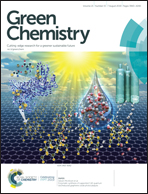Intramolecular electrochemical dehydrogenative N–N bond formation for the synthesis of 1,2,4-triazolo[1,5-a]pyridines†
Abstract
A metal- and oxidant-free intramolecular dehydrogenative N–N bond formation has been developed under mild and scalable electrolytic conditions. Various valuable 1,2,4-triazolo[1,5-a]pyridines were synthesized efficiently from the readily available N-(2-pyridyl)amidines. The reactions were conducted in a simple undivided cell under constant current conditions with nBu4NBr as both the redox mediator and the electrolyte. This protocol was applied to the efficient synthesis of key intermediates for anti-diabetic compounds.
![Graphical abstract: Intramolecular electrochemical dehydrogenative N–N bond formation for the synthesis of 1,2,4-triazolo[1,5-a]pyridines](/en/Image/Get?imageInfo.ImageType=GA&imageInfo.ImageIdentifier.ManuscriptID=C9GC01895F&imageInfo.ImageIdentifier.Year=2019)


 Please wait while we load your content...
Please wait while we load your content...